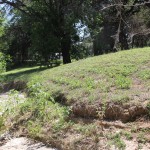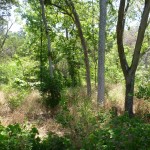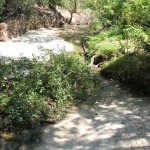SRCC is incredibly lucky to have Todd Jackson from City of Austin Watershed Protection in our neighborhood. Â Not only is he an amazing resource for our community, but he has also submitted the Riparian Zone restoration project on behalf of SRCC as part of the Neighborhood Wildlife Challenge. Â Below is a description of the efforts being made on this project – thank you Todd!
Introduction: A riparian zone (the land adjacent to the creek) acts as a buffer between the aquatic (water) and terrestrial (land) environment and serves to minimize impacts to water quantity and quality. As the riparian zone becomes increasingly degraded (reduced in quality or value) the ecological functions (basic goods and services it provides to humans) can be altered. Therefore, the goal of riparian zone restoration is to restore the natural process necessary to maintain a high level of ecosystem function.
Background: Blunn Creek flows through the center of Big Stacy Park and Little Stacy Park before emptying into Lady Bird Lake. This urban creek has reduced riparian vegetation, elevated streambank erosion, and impaired water quality. Through a joint effort between Parks and Recreation and Watershed Protection, this area has been selected as one of several locations for a new “Grow Zone†initiative. Increasing the vegetation cover has been shown to improve the ecological function of Austin’s riparian zones.
Healthy Riparian Buffers Provide:
- Filtering of storm runoff, removing pollutants before they reach the creek
- Prevention of stream bank erosion
- Slowing of flow, reducing downstream flooding
- “Sponge†like soil conditions that will absorb water, providing baseflow for the creek
- Shade, reducing water temperatures.
- Habitat and food for a diverse group of animals, both on land and in the water
- A Reduction in the City’s carbon footprint via both sequestration and reduced emissions.
- Reduced mowing and maintenance by City staff.
- A greenbelt forest and stream amenity for walkers, hikers and wildlife observers. 
Management Approach:
- Establish a “Grow Zone†along both banks of the creek, approximately 25 ft.
- Allow for passive (natural) plant growth in entire buffer area.
- Monitor for changes over time and apply adaptive management approaches where necessary.
- Coordinate periodic trash removal, weed/invasive vegetation management, and native seeding/planting.
- Install educational and demarcation signage where appropriate
What should park users expect?
- As the plant community recovers, some areas may have taller, much less manicured vegetation. It can take between 5 and 10 years to develop a diverse vegetation community, so patience is important!
Who will track progress and/or Success?
- WPD will evaluate changes annually; implement adaptive riparian restoration practices as needed.
- Volunteer participation is encouraged through the Keep Austin Beautiful, Adopt-A-Creek Program.
City of Austin Research Findings:
- Early results suggest that establishing Grow Zones adjacent to creeks will significantly reduce soil compaction, soil pH, and vegetation gaps and significantly increase soil moisture, vegetation structure, and canopy cover (shade).
- Big Stacy Park’s most recent Riparian Functional Assessment Score (RFA) of 55 (out of 100) is 23 points below its reference site comparison location (the preserve upstream) and needs to be improved.
Upcoming Riparian Management:
- Fall (2012) – seeding and sapling planting.
- Fall (2012) – educational sign posting.
- Winter/Spring (2013) – establish an Adopt-A-Creek group to become stewards/ assist with restoration.
Questions: Please contact Todd Jackson,WPD 974-2206 todd.jackson@austintexas.gov
Website: www.austintexas.gov/watershed/creekside
Adopt-A-Creek: www.keepaustinbeautiful.org/adopt-a-creek







